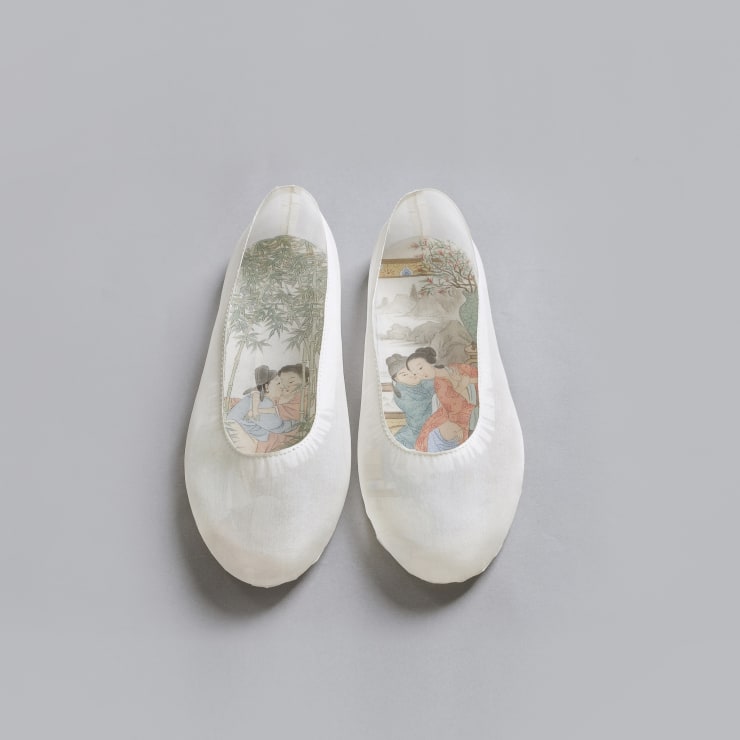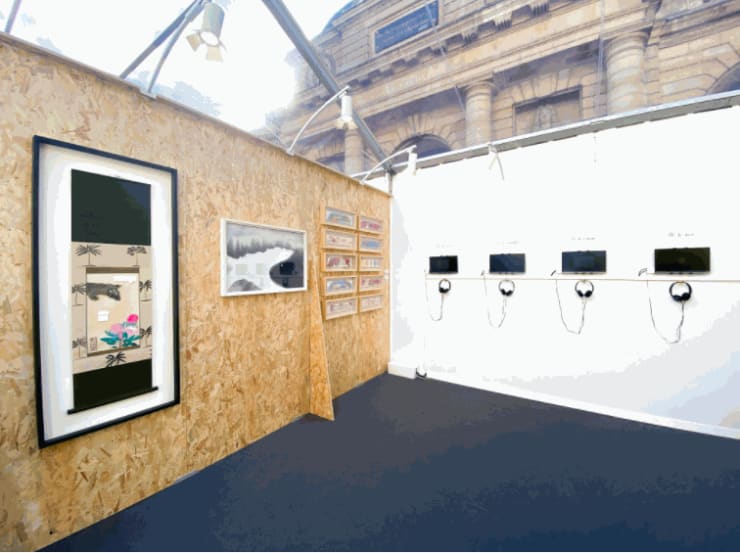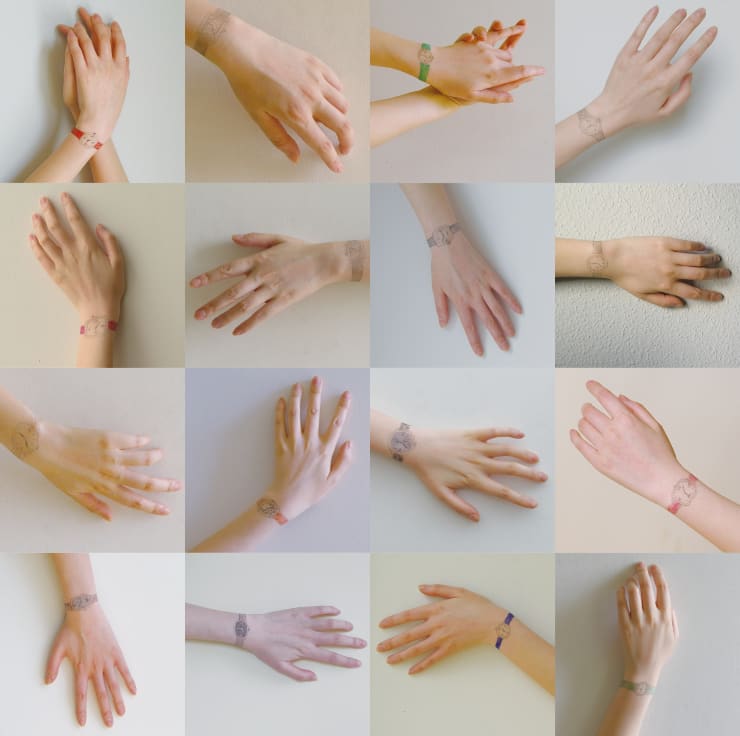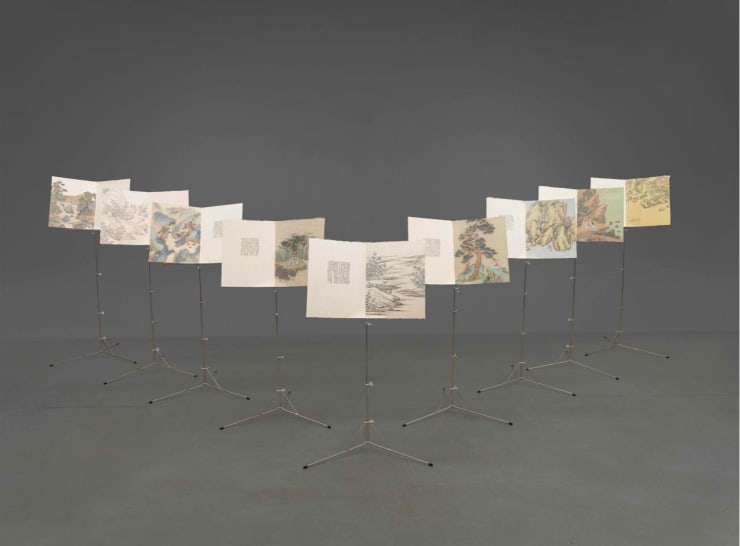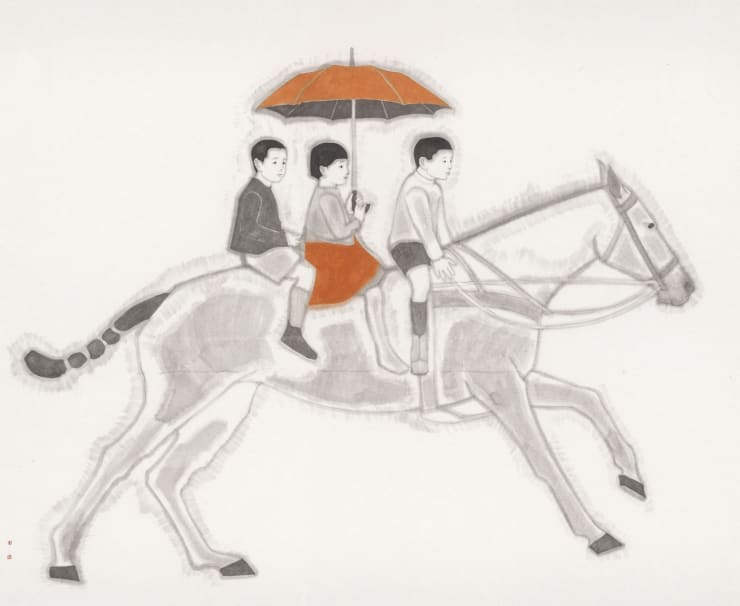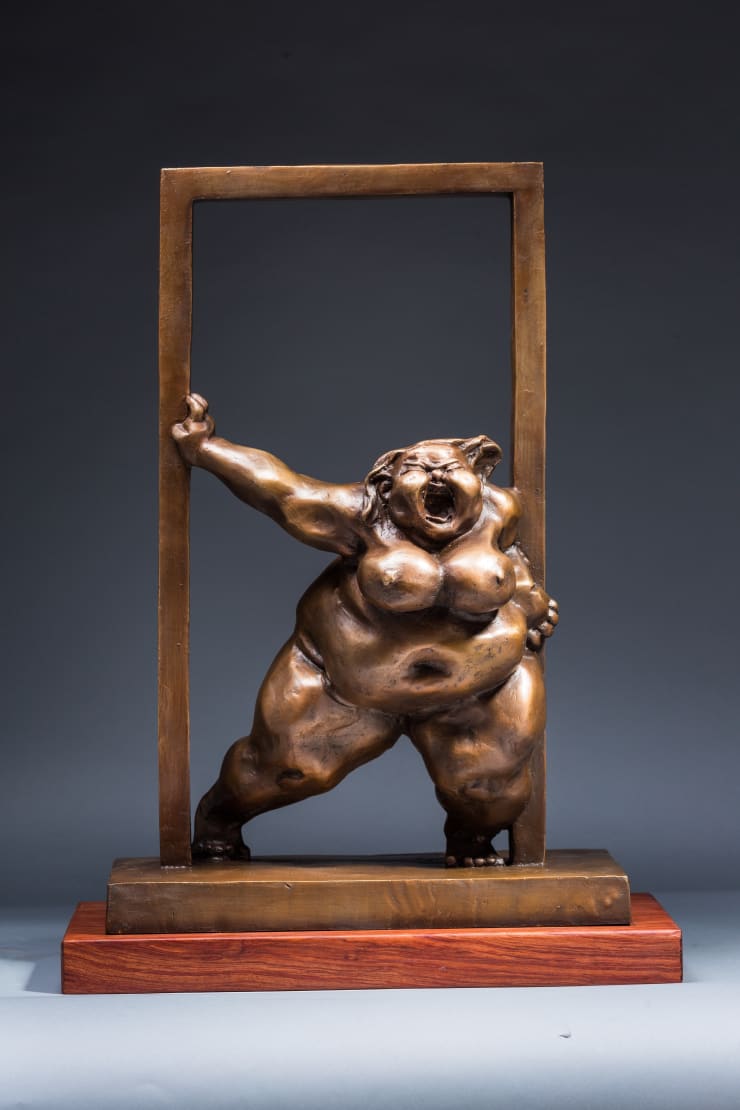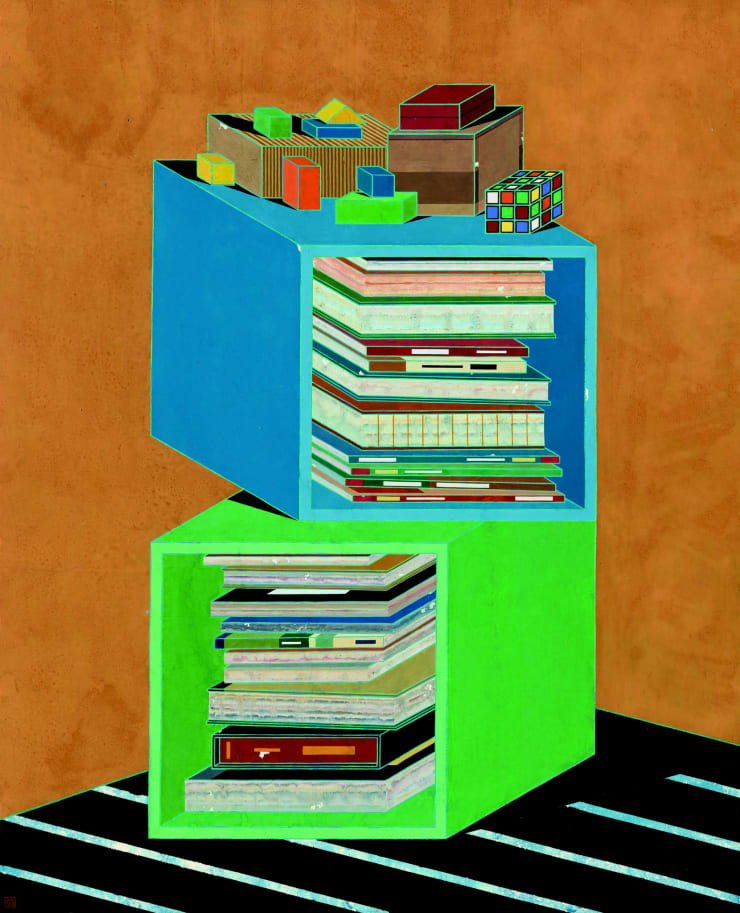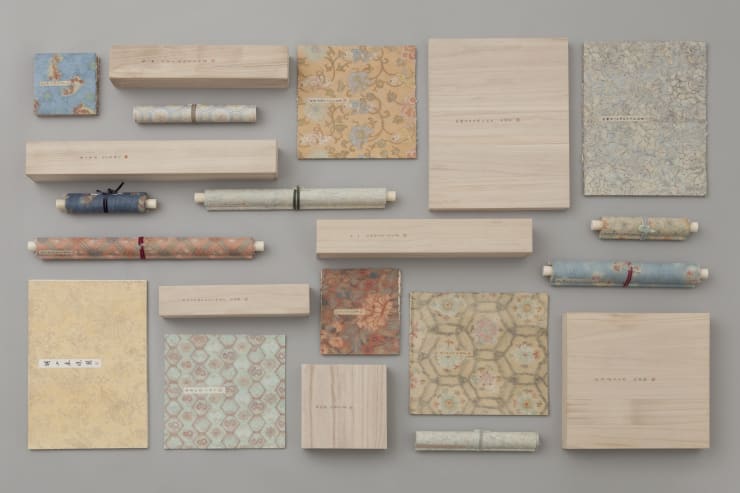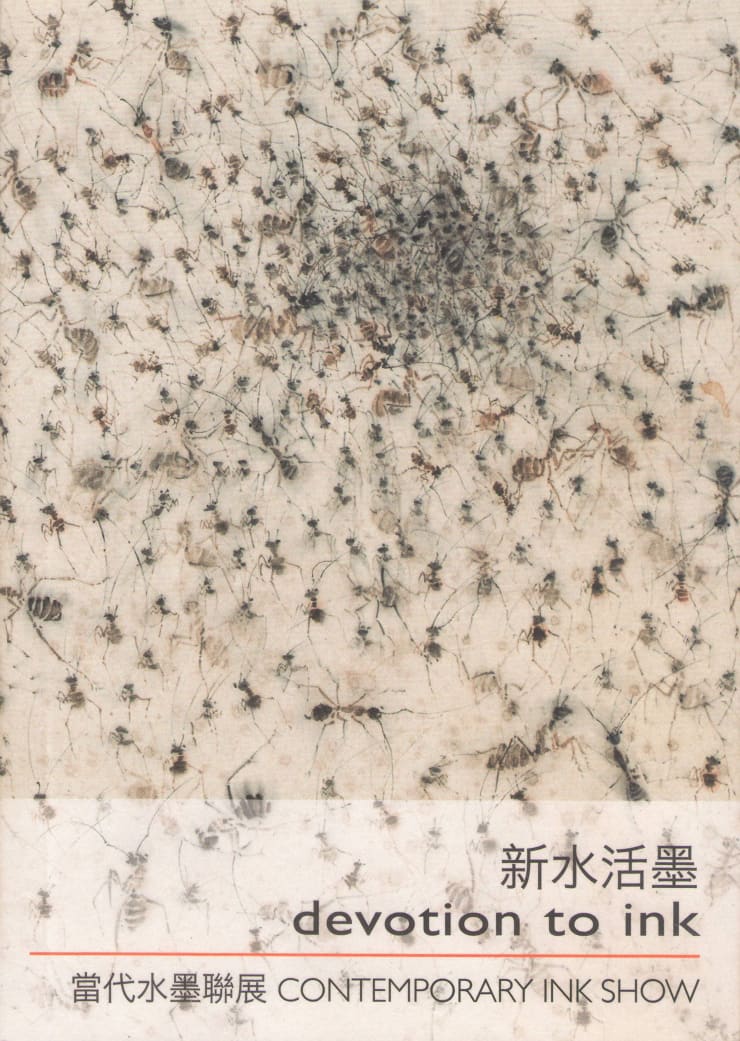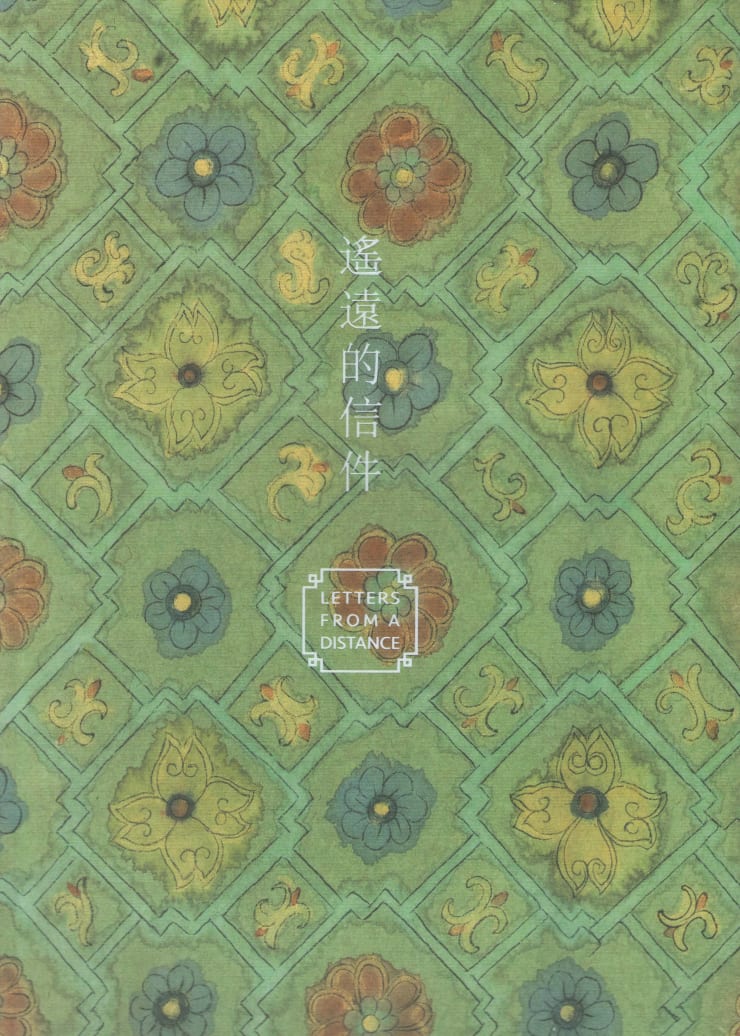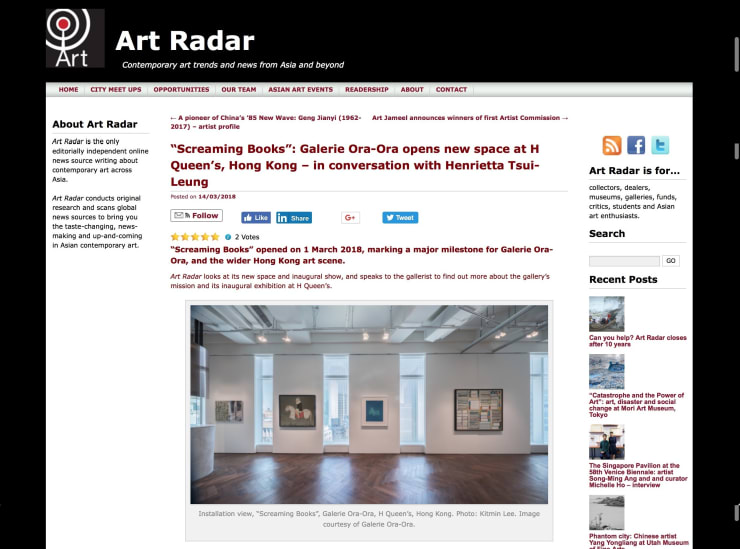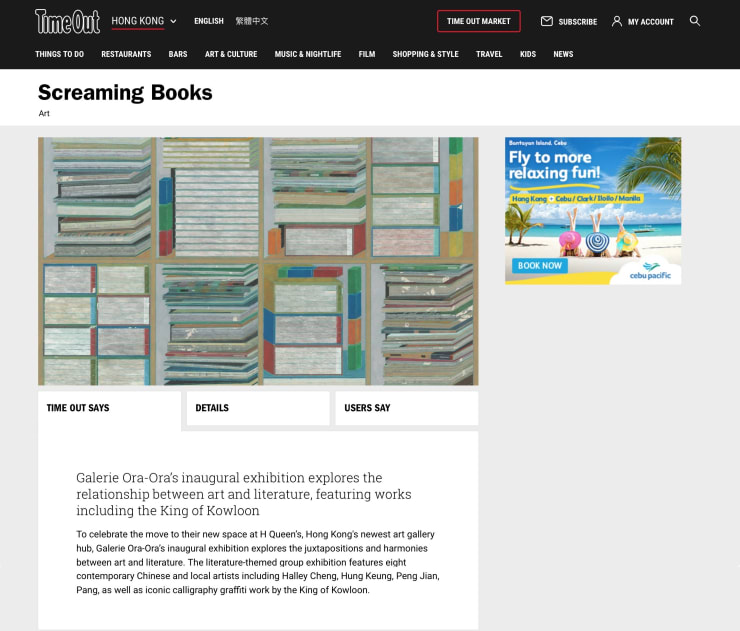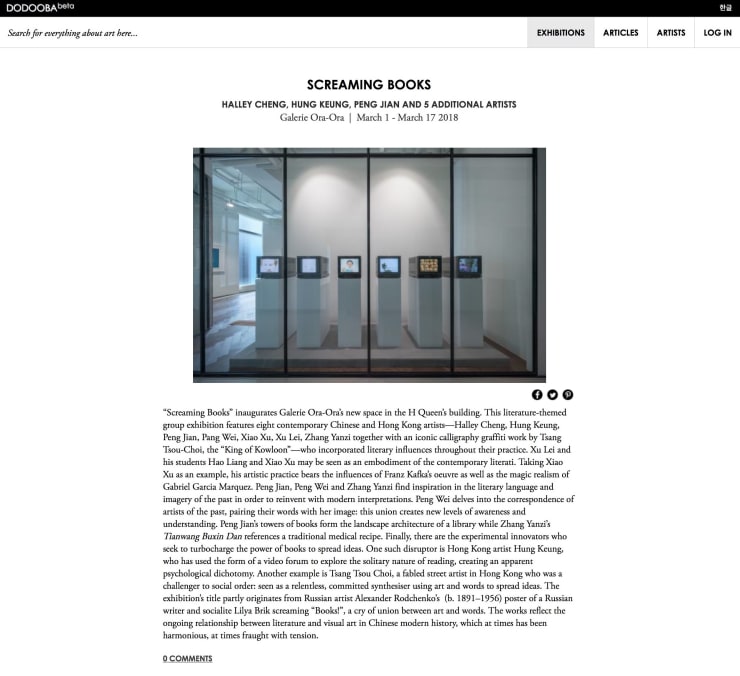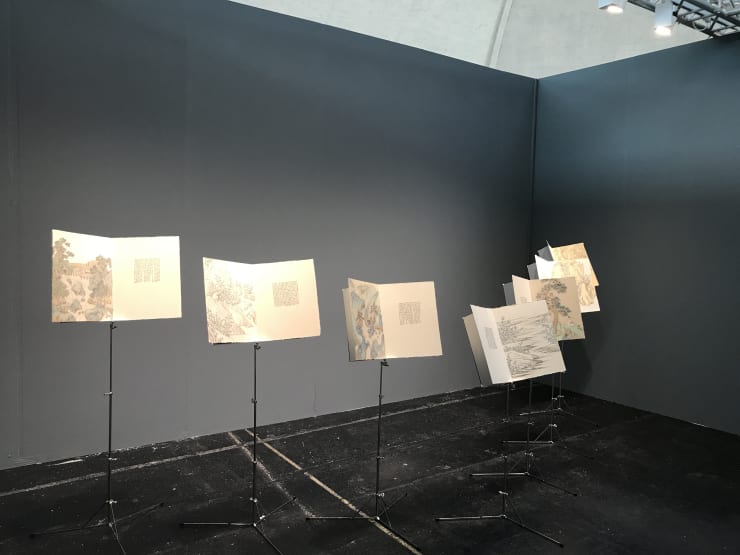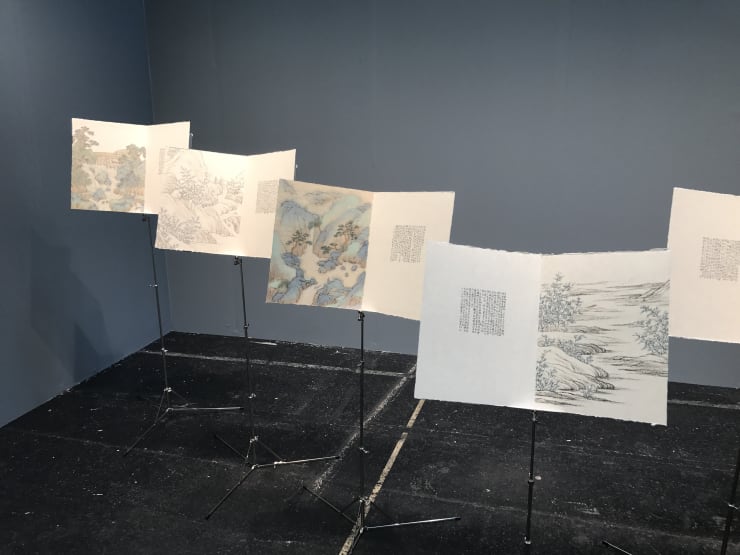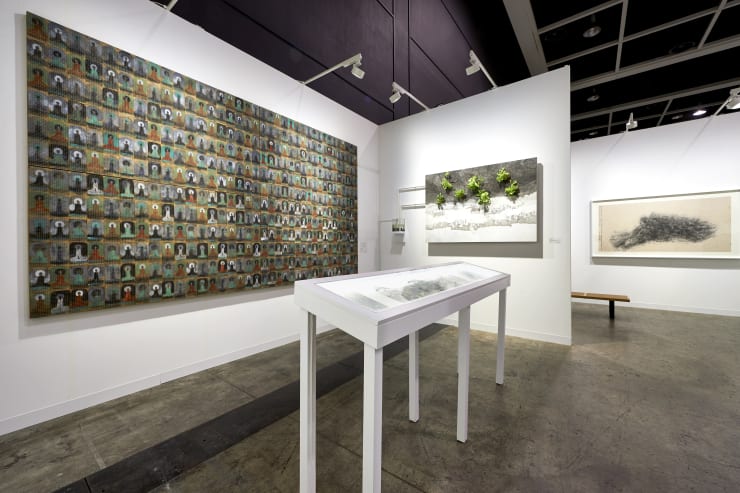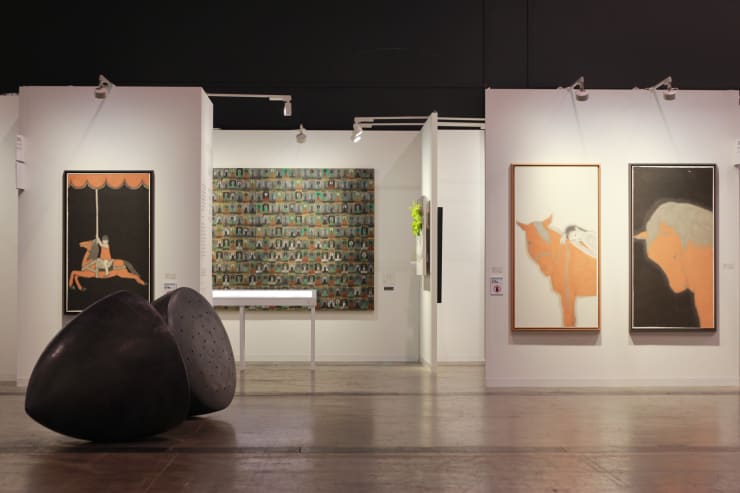Peng Wei 彭薇
Peng Wei was born in Chengdu, China in 1974. She received her bachelor’s degree in Chinese Painting, Oriental Cultural Art from Nankai University (1997), followed by a master’s degree in Philosophy from the same institution (2000). She currently works in Beijing as a senior member at the Beijing Fine Art Academy and member of the China Fine Arts Association.
Peng Wei’s artworks harness ink to merge the past with the present through unique and surprising juxtapositions. Recurrent threads of her work include the depiction of clothing, fans and scholars’ rocks, her use of scrolls, and her pairing of texts of western thinkers with classical Chinese imagery, to skew or re-interpret our assumptions of the past. Humour and affection are never far from the surface; in the words of the artist, “I always strive to create a more perfect work. We need perfection, but the meaning of life lies not in perfection, but in love.”
Peng Wei’s work is in the collection of the National Art Museum of China, the Hong Kong Museum of Art, the Asian Art Museum of San Francisco, the Guangdong Art Museum, the He Xiangning Art Museum, the M+ Museum, the Uli Sigg Collection, the DSL Collection and many more.
Her solo exhibitions include Feminine Space: Peng Wei at the Guangdong Museum of Art (2020), Old Tales Retold at Tang Contemporary Art (2019) and I Thought of You at the Suzhou Museum (2017). She has exhibited at the Venice Biennale (2017) and several times with Ora-Ora at Art Basel Hong Kong.
-

Semper Femina
18 Jul - 20 Aug 2023Ora-Ora is pleased to announce a group show of entirely female artists, comprising contributions from Peng Wei, Huang Dan, Zhang Yanzi and Nina Pryde. The title is “Semper Femina.” Semper...Read more -

Asia Now Paris 2022
Feux de Joie 20 - 23 Oct 2022Ora-Ora is pleased to announce its participation in the 8th edition of Asia Now, which takes place in Paris between 20-23 October 2022. This edition marks Ora-Ora’s (Booth H07) first...Read more -

Anticipation
24 Jan - 9 Mar 2019Galerie Ora-Ora is delighted to kick start the year of 2019 with Anticipation, a dynamic group exhibition that shares the passion of artists who explore, express or investigate the identity...Read more -

Screaming Books
1 - 17 Mar 2018Galerie Ora-Ora’s opening show asserts the universality of art, and its role as a standard bearer for unbarriered, unfettered expression and understanding. Where words belong to language silos, imbued with...Read more -

Volta13
12 - 17 Jun 2017Galerie Ora-Ora at VOLTA 13, Basel, Switzerland will present epistolary anecdotes from the lives of history's greatest musicians, illustrated by Peng Wei. Cocooned in a darkened space, visitors will be...Read more -

INK ASIA 2016
15 - 18 Dec 2016Galerie Ora-Ora invites the visitor on a journey of celebration into the rich imaginations of our pioneering contemporary ink artists. Artists committed to actualizing their most modern, vivid dreams through...Read more -

Art Basel Hong Kong 2016
Cha-Na 22 - 26 Mar 2016Cha-Na is the study of the instance, its nature, importance, reflections, iterations and incarnations. Philosophers believe the instance is sacred and has fundamental importance to understanding the existence of the...Read more -

Cha-Na
21 Mar - 23 Apr 2016For this year’s Art Gallery Night, Ora-Ora will present “Cha-Na” as a continuation of our exhibition at Art Basel Hong Kong 2016. Cha-Na is the study of the instance, its...Read more -

Winter Sunrise - A Joint Sculpture Exhibition
6 - 23 Nov 2015Each November brings Hong Kong Art Gallery Week, a week-long Arts Festival of Talks, Tours, Studio Visits, circling Art Buses touring the different art districts, Art Lates as well as...Read more -

Fine Art Asia 2015
Chubby Comedy - Xu Hongfei 4 - 7 Oct 2015With fluid, vivid poses and buxom female bodies, world renowned sculptor Xu Hongfei’s “Chubby Women” sculptures convey a sense of exquisiteness, representing the beauty of freedom and revealing the powerful...Read more -

Art15 London
21 - 23 May 2015Ora-Ora participated at Art15 London from 21-23 May and the show was well received by both local and international audiences. We were delighted to stage the works of renowned Chinese...Read more -

START Art Fair
25 - 29 Jun 2014London's newest art fair, START drew to a successful close at the Saatchi Gallery on 29th June 2014. The fair was particularly international in scope: 46 galleries came from 21...Read more -

Devotion to Ink Contemporary Ink Show
17 - 19 May 2014With over one thousand years of history, ink art has evolved from traditional ink to create a contemporary aesthetic standard and visual experience. In harmony with Art Basel Hong Kong,...Read more -

Art Basel Hong Kong 2014
Letters From a Distance - Peng Wei 14 - 18 May 2014Recognizing Art Basel’s leadership in contemporary art, Ora-Ora believes this is an important opportunity to help connect international collectors and enthusiasts with the fundamental elements of ink, a medium that...Read more
-

(Hong Kong Arts Month) The most concentrated art space in Central
March 16, 2018香港01 Once galleries were blooming in the city of Hong Kong, yet, normally with locations rather far away from the crowd. Ever since the inauguration...Read more -

Founder of Galerie Ora-Ora, Henrietta Tsui-Leung: It’s necessary to create a blooming industry for arts; and it’s a pleasure to compete with powerful rivals
March 16, 2018Artron Galerie Ora-Ora is proud to celebrate the opening of their new space in the H Queen’s building in March, where its new art space...Read more -

“Screaming Books”: Galerie Ora-Ora opens new space at H Queen’s, Hong Kong – in conversation with Henrietta Tsui-Leung
March 14, 2018Art Radar Founded by Henrietta Tsui-Leung ten years ago in Hong Kong, Galerie Ora-Ora is a research-based contemporary art gallery specialising in sculpture and works...Read more -

Screaming Books
March 1, 2018TimeOut Galerie Ora-Ora’s inaugural exhibition explores the relationship between art and literature, featuring works including the King of Kowloon. To celebrate the move to their...Read more -

A purpose-built art building bringing the galleries together
March 1, 2018Sing Tao Daily Entering “Hong Kong Arts Month” with the upcoming significant exhibitions and events, lovers and readers for culture and arts have already filled...Read more -

"Screaming Books" – Halley Cheng, Hung Keung, Peng Jian and 5 Additional Artists
March 1, 2018DODOOBA “Screaming Books” inaugurates Galerie Ora-Ora’s new space in the H Queen’s building. This literature-themed group exhibition features eight contemporary Chinese and Hong Kong artists—Halley...Read more -

Galerie Ora-Ora latest show "Screaming Books" at H Queen's
March 1, 2018Artron News Galerie Ora-Ora is proud to celebrate the opening of the new space in the H Queen’s building with an inaugural exhibition that explores...Read more -

Local Talent: 7 Must-See Exhibitions At Hong Kong's Homegrown Galleries
February 20, 2018Hong Kong Tatler There’s more to Hong Kong’s art scene than the celebrated shows at big international galleries. Here’s our pick of upcoming exhibitions at...Read more -

‘Screaming Books’ at Ora-Ora, Hong Kong
February 8, 2018Blouin ArtInfo Galerie Ora-Ora is hosting an exhibition titled “Screaming Books” at its Hong Kong venue. Galerie Ora-Ora’s exhibition “Screaming Books” asserts the universality of...Read more -

Volta Basel 2017 - The Art Fair for New International Positions
June 16, 2017VOLTA Basel aims at providing a platform for international galleries. Due to the eclectic and dynamic presentations with a strong focus on solo shows, it...Read more -

Smaller and Scrappier, VOLTA 13 Promises to Be One of the Best Fairs This Season
June 14, 2017artnet.com Dealers are gearing up for the “lucky” 13th edition of VOLTA, Art Basel’s globally conscious satellite fair that serves as a platform for emerging...Read more -

Art Radar Brings You 6 Must-See Gallery Booths at VOLTA Art Fair in Basel.
June 14, 2017Art Radar Launched on 12 June 2017, VOLTA 13 in Basel presents 70 galleries from 43 cities around the world, with a focus on solo...Read more -

Rulers and stereotypes: A first stroll through the Volta 13
June 12, 2017Barfi.ch We conclude our tour with the installation 'Migrations of Memory' of the Chinese artist Peng Wei at the booth of Galerie Ora-Ora. While the...Read more -

The 20 Best Booths at Art Basel in Hong Kong
March 22, 2016Artsy After a stint in the fair's Insights section last year, Ora-Ora graduates to Galleries with a curated exhibition, 'Cha-Na.' Addressing ideas around instantaneousness and...Read more -

Art Big Bang: March
March 11, 2016Hong Kong 01 More than 3 billion years ago, the universe is but a micro singular dot of measureless weight. There is no starry sky,...Read more -

Art Interview: Peng Wei and Henrietta Tsui
June 1, 2014Baccarat Hong Kong Among the mayhem that was Art Basel in Hong Kong 2014 was a petite and demure Chinese artist called Peng Wei, whose...Read more -

“Letter from a Distance” Peng Wei Solo Exhibition at Art Basel Hong Kong
May 30, 2014KUART Galerie Ora-Ora will be presenting Letter from a Distance - Peng Wei Solo Exhibition at this year's Art Basel Hong Kong, from 14 to...Read more




